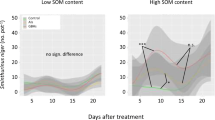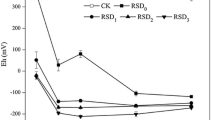Abstract
Untreated acid mine drainage (AMD) is being considered for crop irrigation on strategically limed soils, but foliar scorching is of potential concern. To test whether crops might be protected by antitranspirants, a field trial and two glasshouse pot trials were undertaken during the 2020/2021 growing seasons. Crops, namely Sorghum bicolor, Zea mays, Glycine max, Vigna unguiculata, Triticum aestivum, Avena sativa, Medicago sativa, and Pisum sativum, were exposed to acid water with pH levels of 2.0, 2.5, 3.0, 4.0, and 7.0. The first pot trial and field trial tested the effects of sulphuric acid solutions (to simulate AMD) on leaf scorching and the second pot trial focused on the effectiveness of an antitranspirant, Wiltpruf®, in protecting crops against leaf scorching. Leaf scorching occurred at pH levels of 2.0, 2.5, and 3, but only to a maximum of 6% leaf area damage in the worst-affected crop species. Crops are likely to recover from this injury. Contrary to expectations, the antitranspirant increased the propensity for foliar injury among crops, especially at pH 2.0 and 2.5. Metal cations commonly found in AMD should be included in follow-up leaf scorching studies to better simulate likely AMD irrigation waters. However, it appears that any crop growth problems possibly encountered when irrigating with AMD are likely to stem from root zone effects.
Resumen
El drenaje ácido de mina (DAM) sin tratar se está considerando para el riego de cultivos en suelos estratégicamente encalados, pero la quemadura foliar es una potencial consecuencia. En función de probar si los cultivos podrían protegerse con antitranspirantes, se llevó a cabo un ensayo de campo y dos ensayos en macetas de invernadero durante las temporadas de cultivo 2020/2021. Los cultivos, concretamente Sorghum bicolor, Zea mays, Glycine max, Vigna unguiculata, Triticum aestivum, Avena sativa, Medicago sativa y Pisum sativum, se expusieron a agua ácida con niveles de pH de 2,0, 2,5, 3,0, 4,0 y 7,0. El primer ensayo en macetas y el ensayo de campo probaron los efectos de las soluciones de ácido sulfúrico (para simular el AMD) en el quemado de las hojas y el segundo ensayo en macetas se centró en la eficacia de un antitranspirante, Wiltpruf®, en la protección de los cultivos contra el quemado de las hojas. El quemado de las hojas se produjo a niveles de pH de 2,0, 2,5 y 3, pero sólo hasta un máximo del 6% de superficie foliar dañada en las especies de cultivos más afectadas. Es probable que los cultivos se recuperen de este daño. Contrariamente a lo esperado, el antitranspirante aumentó la propensión a las lesiones foliares entre los cultivos, especialmente a pH 2,0 y 2,5. Los cationes metálicos que se encuentran comúnmente en AMD deberían incluirse en los estudios de seguimiento de quemaduras foliares para una mejor simulación de las probables aguas de riego de AMD. Sin embargo, parece que los problemas de crecimiento de los cultivos que puedan surgir al regar con AMD se derivan probablemente de los efectos en la zona radicular.
摘 要
未经处理的酸性矿井水(AMD)被考虑用于石灰土壤上种植农作物的灌溉,但灌溉引起地作物叶片灼伤是一个潜在的问题。为了测试抗蒸腾剂是否可以保护作物,我们在2020和2021年作物的生长季节进行了一项田间试验和两项温室盆栽试验。将高粱、玉米、大豆、豇豆、小麦、燕麦、苜蓿和豌豆分别置于pH为2.0、2.5、3.0、4.0和7.0的酸性水中。第一项盆栽试验和田间试验测试了硫酸溶液(模拟AMD)对叶片灼伤的影响,第二项盆栽试验重点研究了抗蒸腾剂Wiltpruf®在保护作物免受叶片灼伤的效果。结果表明:在pH值为2.0、2.5和3的情况下叶片会被灼伤,但在受影响最严重的作物品种中,仅造成6 %叶片面积的灼伤,作物可以自行恢复;与预期相反,使用抗蒸腾剂增加了作物叶片灼伤的倾向,尤其是pH值为2.0和2.5时。在后续的叶片灼伤研究中,应考虑AMD中常见的金属阳离子,以更好地模拟可能的AMD灌溉水。然而,在使用AMD灌溉时可能遇到的任何作物生长问题都可能源于根区效应。








Similar content being viewed by others
Data availability
The authors confirm that the data supporting the findings of this study are available within the article.
References
Aggag AM, Alzoheiry AM, Abdallah AE (2015) Effect of kaolin and fulvic acid antitranspirants on tomato plants grown under different water regimes. Alex Sci Exch 36(2):169–180. https://doi.org/10.21608/ASEJAIQJSAE.2015.2875
Alheeti AAM, Farhan MA, Al-Saad LA, Theer RM (2021) Evaluation of the performance of imagej, leaf doctor applications, and visual assessments in measuring severity of two leaf spot diseases. Earth Environ Sci 761(1):12–30
Chalker-Scott L (2015) The myth of antitranspirants. Puyallup Research and Extension Center. Washington State University, Washington
Cinque MT (1979) Protecting fall plantings from the ravages of winter. Nassau County, NY, USA.
Curry T (1978) histological study of the effects of acid rain on leaf tissue of Pteridium aquilinum and Quercus palustris. Biol Soc Wash 49(4):157–164. https://doi.org/10.2307/4607495
Davenport DC, Uriu K, Hagan RM (1974) Effects of film antitranspirants on growth. J Exp Bot 25(2):410–419. https://doi.org/10.1093/jxb/25.2.410
Du E, Dan D, Xuetong Z, Zhengzhong S, Xiaofei J, Wim V (2017) Direct effect of acid rain on leaf chlorophyll content of terrestrial plants in China. Sci Total Environ 605–606:764–769. https://doi.org/10.1016/j.scitotenv.2017.06.044
Edje OT, Ossom EM (2009) Crop science handbook. Blue Moon Publishers, Manzini
Elfving DC, Gilbert MD, Edgerton LJ, Wilde MH, Lisk DJ (1976) Antioxidant and antitranspirant protection of apple foliage against ozone injury. Bull Environ Contam Toxicol 15(3):336–341. https://doi.org/10.1007/BF01812646
El-Sayed D, Tohamy M, Eisa G, El-Sarkassy N (2013) Effect of some antitranspirant substances on growth, yield and flag leaf structure of wheat plant (Triticum aestivum L.) grown under water stress conditions. Zagazig J Agric Res 40(2):215–230
Guleria V, Shweta A (2020) Antitranspirants: an effective approach to mitigate the stress in field crops. Int J Curr Microbiol Appl Sci 9(5):1671–1678. https://doi.org/10.20546/ijcmas.2020.905.188
Jacobson JS, Heller LI, Yamada KE, Osmeloski JF, Bethard T (1989) Foliar injury and growth response of red spruce to sulfate and nitrate acidic mist. Environmental Biology Program. Boyce Thompson Institute for Plant Research, Ithaca
Jovanovic NZ, Annandale JG, van der Westhuizen AM, Steyn JM (2004) Monitoring the effect of irrigation with gypsiferous mine wastewater on crop production potential as affected by soil water and salt balance. J South Afr Inst Min Metall 104:73–81
Keever GJ (1982) Plant response to simulated acid rain with special reference to foliar injury, foliar leaching, trichome status and plant nutrition. United States of America. https://www.osti.gov/biblio/6577719. Accessed 24 May 2021
Keever GJ, Jacobson JS (1983) Response of Glycine max (L.) Merrill to simulated acid rain II. Localization of foliar injury and growth response. Field Crops Res 6:251–259. https://doi.org/10.1016/0378-4290(83)90065-5
Kohno Y (2017) Effects of simulated acid rain on Asian crops and garden plants. Air Pollution Impacts on Plants in East Asia, Springer, p. 223–235
Minolta K (2017) Chlorophyll meter SPAD-502Plus. Accessed 14 July 2021. https://www5.konicaminolta.eu/fileadmin/content/eu/Measuring_Instruments/2_Products/1_Colour_Measurement/6_Chlorophyll_Meter/PDF/spad-502plus_Feb2017_EN.pdf
Kumari S, Chauhan J (2017) Antitranspirants and their role in agriculture. Accessed 1 June 2021. https://www.biotecharticles.com/Agriculture-Article/Antitranspirants-and-their-Role-in-Agriculture-3991.html
Kumari S, Udayabhanu G, Prasad B (2010) Studies on environmental impact of acid mine drainage generation and its treatment: an appraisal. Indian J Environ Prot 30(11):953–967
Lee JJ, Neely GE, Perrigan SC, Grothaus LC (1981) Effects of simulated sulfuric acid rain on yield, growth and foliar injury of several crops. Environ Exp Bot 21:171–185
Madiseng L (2018) Crop response to irrigation with acidic and neutralised saline mine water. Dissertation, University of Pretoria.
Mphande W, Kettlewell PS, Grove IG, Farrell AD (2020) The potential of antitranspirants in drought management of arable crops: a review. Agric Water Manag 236:106–143. https://doi.org/10.1016/j.agwat.2020.106143
Odiyi BO, Eniola AO (2015) The effect of simulated acid rain on plant growth component of cowpea (Vigna unguiculata) L. Walps. Jordan J Biol Sci 1: 51–54. https://doi.org/10.12816/0026948
Percy KE, Baker EA (1987) Effects of simulated acid rain on production, morphology and composition of epicuticular wax and on cuticular membrane development. New Phytol 107: 577–589. http://www.jstor.org/stable/2434444
Pham HT, Nguyen AT, Do ATN, Hens L (2021) Impacts of simulated acid rain on the growth and the yield of soybean (Glycine max (L.) Merr.) in the mountains of Northern Vietnam. Sustainability 13:4980
R Core Team (2013) R: a language and environment for statistical computing. R Foundation for Statistical Computing, Vienna, Austria
Rodríguez-Sánchez VM, Rosas U, Calva-Vásquez G, Sandoval-Zapotitla E (2020) Does acid rain alter the leaf anatomy and photosynthetic pigments in urban trees? Plants 9:862–872. https://doi.org/10.3390/plants9070862
Sagta HC, Nautiyal S (2002) Effect of water stress and antitranspirants on chlorophyll contents of Dalbergia sissoo Roxb leaves. Indian for 128(8):893–902
Sant’Anna-Santos BF, Silva LCD, Azevedo AA, Aguiar R (2006) Effects of simulated acid rain on leaf anatomy and micromorphology of Genipa americana L. (Rubiaceae). Braz Arch Biol Technol 49:313–321
Schneider CA, Rasband WS, Eliceiri KW (2012) NIH image to image J: 25 years of image analysis. Nat Methods 9(7):671–675
Shepherd T, Griffiths TD (2006) The effects of stress on plant cuticular waxes. New Phytol 171:469–99. https://doi.org/10.1111/j.1469-8137.2006.01826.x
Shi Z, Zhang J, Xiao Z, Lu T, Ren X, Wei H (2021) Effects of acid rain on plant growth: a meta-analysis. J Environ Manage 297:113213
Silva LC, Azevedo AA, Silva EAM, Oliva MA (2005) Effects of simulated acid rain on the growth of five Brazilian tree species and anatomy of the most sensitive species. Aust J Bot 53:789–796. https://doi.org/10.1071/BT040960067-1924/05/080789
Soil Classification Working Group (1991) Soil classification: a taxonomic system for South Africa. Dept of Agricultural Development, Pretoria
Sun J, Hu H, Li Y, Wang L, Zhou Q, Huang X (2016) Effects and mechanism of acid rain on plant chloroplast ATP synthase. Environ Sci Pollut Res 23(18):18296–18306
Windish B (2016) Antitranspirants: everything you wanted to know about protecting your plants during cold weather. Fairway Green Inc, Hillsborough
Acknowledgements
We thank the Water Research Commission (WRC) of South Africa for their funding of this work (grant 2021/2023-00555).
Author information
Authors and Affiliations
Corresponding author
Rights and permissions
Springer Nature or its licensor (e.g. a society or other partner) holds exclusive rights to this article under a publishing agreement with the author(s) or other rightsholder(s); author self-archiving of the accepted manuscript version of this article is solely governed by the terms of such publishing agreement and applicable law.
About this article
Cite this article
Mabuza, M., Annandale, J., Steyn, M. et al. Leaf Scorching due to Foliar Application of Synthetic Acid Mine Drainage and the Effectiveness of an Antitranspirant in Protecting Leaves. Mine Water Environ 42, 98–110 (2023). https://doi.org/10.1007/s10230-023-00920-y
Received:
Accepted:
Published:
Issue Date:
DOI: https://doi.org/10.1007/s10230-023-00920-y




